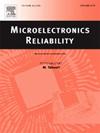具有电阻桥接故障的 QDI 电路的 NBTI 效应实验分析
IF 1.6
4区 工程技术
Q3 ENGINEERING, ELECTRICAL & ELECTRONIC
引用次数: 0
摘要
检测延迟不敏感电路(DIC)中的缺陷,尤其是无时钟异步电路中的缺陷,是一项重大挑战。传统的测试方法非常复杂,而且开销巨大。异步电路的稳健性对于确保关键系统的安全性和可靠性至关重要,因为未检测到的缺陷可能会危及系统的运行。为了应对这些挑战,我们的方法利用异步电路独特的电压特征来识别电阻缺陷。通过 FPGA 实验,我们证明了电路生成信息电压特征的能力,从而促进了这些缺陷的检测。此外,我们还对电阻缺陷检测和负偏压温度不稳定性(NBTI)引起的老化对准延迟不敏感(QDI)电路的影响进行了综合分析。这项分析强调了缺陷如何逃避制造测试,并随着时间的推移演变成动态故障。我们的结果提供了对这种影响的精确评估,并提出了一种在现实操作条件下评估电路鲁棒性的综合方法。本文章由计算机程序翻译,如有差异,请以英文原文为准。
Experimental analysis of NBTI effects on QDI circuits with resistive bridging faults
Detecting defects in Delay-Insensitive Circuits (DIC), particularly for clockless asynchronous circuits, poses a major challenge. Traditional testing methods are complex and result in significant overhead. The robustness of asynchronous circuits is crucial for ensuring the safety and reliability of critical systems, as undetected defects can compromise their operation. To address these challenges, our method leverages the unique voltage signatures of asynchronous circuits to identify resistive defects. Through our FPGA experiments, we demonstrated the circuits' ability to generate informative voltage signatures, thereby facilitating the detection of these defects. Additionally, we performed a combined analysis of resistive defect detection and the impact of aging caused by Negative-Bias Temperature Instability (NBTI) on Quasi Delay Insensitive (QDI) circuits. This analysis highlights how defects can evade manufacturing tests and evolve into dynamic faults over time. Our results provide a precise evaluation of this impact and propose a comprehensive approach to assess circuit robustness under realistic operating conditions.
求助全文
通过发布文献求助,成功后即可免费获取论文全文。
去求助
来源期刊

Microelectronics Reliability
工程技术-工程:电子与电气
CiteScore
3.30
自引率
12.50%
发文量
342
审稿时长
68 days
期刊介绍:
Microelectronics Reliability, is dedicated to disseminating the latest research results and related information on the reliability of microelectronic devices, circuits and systems, from materials, process and manufacturing, to design, testing and operation. The coverage of the journal includes the following topics: measurement, understanding and analysis; evaluation and prediction; modelling and simulation; methodologies and mitigation. Papers which combine reliability with other important areas of microelectronics engineering, such as design, fabrication, integration, testing, and field operation will also be welcome, and practical papers reporting case studies in the field and specific application domains are particularly encouraged.
Most accepted papers will be published as Research Papers, describing significant advances and completed work. Papers reviewing important developing topics of general interest may be accepted for publication as Review Papers. Urgent communications of a more preliminary nature and short reports on completed practical work of current interest may be considered for publication as Research Notes. All contributions are subject to peer review by leading experts in the field.
 求助内容:
求助内容: 应助结果提醒方式:
应助结果提醒方式:


